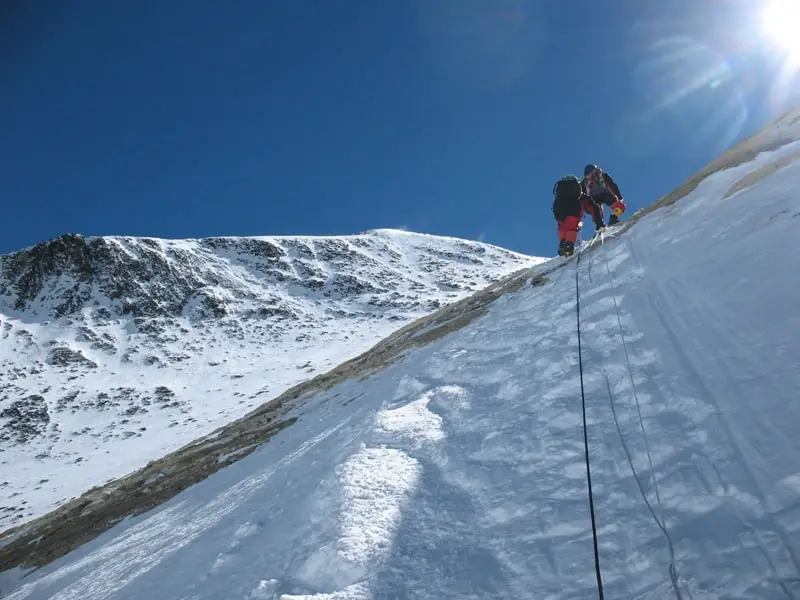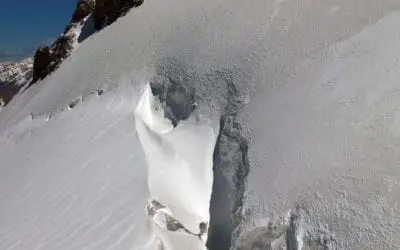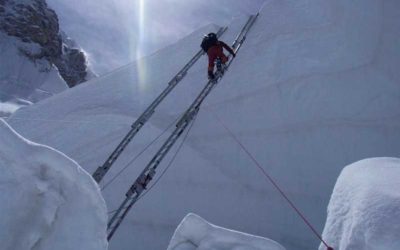
Farouk Zouman leads the team towards the summit, Mt Everest. Photo from Saudi.now
I would definitely be nuts if I would pay around 65,000 US dollars to Sherpa’s implements, prepared guides, permits and government taxes by Nepal and among other expenses etc. Or would I?
As we know, Mount Everest is the tallest mountain (29,029 ft) in the world, but it is not the hardest mountain to climb.
Though Everest got the height but its routing is better than mountains such as Annapurna and K2. You are also given more support in terms of availability of teams, sherpas and equipment. Still Mount Everest has a height of 8,848 meters above sea level, so, of course climbing Everest is not very easy and any bad movement can result in death. The 3.4% out of every hundred people that try to reach the top of Mount Everest die in the attempt and their corpses remain on the mountain in most cases.
The highest mountain was discovered by George Everest, who served as the Indian Secretary-General, in 1841. Since then, the official name, which was given to the highest peak of the Earth, comes from the name of the discoverer.
Prior to this, in different countries, the summit was called differently, based on local languages. But since the highest point on the planet should have a single and understandable name for everyone, the name of the official who discovered it became internationally recognized.
The Difficulties of Everest
If you think that everyone can climb Everest, even if you are full of passion, you are greatly mistaken. Firstly, it is very expensive, about 65,000 dollars.
Secondly, climbing the world’s tallest mountain is not just a fun adventure. It is important to understand that this is not ordinary cozy tourism, but a challenge and risk of mortal danger.
Every year, several tourists die in an attempt to conquer this rocky peak, somebody falls into the abyss or the gap between the glaciers, someone does not withstand the high temperatures, and someone gets sick due to altitude sickness.
Naturally, such type of a difficult test will require serious preparation and a huge amount of special equipment like shoes, clothing, tools, and gadgets.
A large group of experts and assistants are also required to properly organize the trip and they must have many years of experience in climbing other peaks.
But if we talk about the process itself, then this is, of course, extremely fascinating. No matter which route you choose, it is recommended to travel with a companion “Sherpa”.
How Sherpas aid climbers on Everest
Today, this region is home to about 3,000 Sherpas, and all sherpas are first-class guides, helpers and porters, as well as conquerors of the summits.
In short, Sherpas are a nation of Highlanders.
The most popular way to climb Everest is an expedition under the guidance of a guide and in the popular season of spring, autumn is not very reasonable.
When you climb in the guidance of an expert or sherpa, this ensures that the person is a professional who knows the most reliable path to reach to the top. In addition, his knowledge and experience can be relied on even in the most unpredictable situations.
The sherpa will be able to explain everything you need to know before starting the ascent, help choose the necessary equipment and check your physical condition, as well as your state of health, in advance.

Climbing through the Yellow Band, Mt. Everest. Photo from Lloyd Smith
First Step to Climb Everest
The very first step for climbing Everest is to have excellent physical condition, do proper preparation and must having a true experience of climbing other peaks as the adventure is quite risky and dangerous and requires certain skills.
It begins in one of the base camps (on the southern or northern slope), which is selected depending on the route and the ascent plan. So, to get to the base camp, located at an altitude of about 5,000 m (16,000 ft) above sea level, participants require about a week. Here they talk with experienced guides, check their physical condition and get some rest before climbing Everest. Then, for an additional fee, climbers can resort to using Sherpa mountaineers, who will help bring the necessary equipment.
How Long It Would Take to Reach the Peak of Everest
Of course, climbing to the top of the world does not mean a walk on the beautiful snow covered slopes. For less trained climbers and for people who have a minimal risk of any a disease, the adaptation period at medium altitude (in the base camp at an altitude of 5100 meters above sea level) in some cases can reach 30-40 days.
For the whole month, you will be surrounded by Sherpa and your companions until your body gets used to the pressure of the atmosphere and the lack of oxygen. Only then afterwards you can continue climbing.
On average, when it comes to tourist expeditions, the duration of the entire ascent (from the moment you arrive in Kathmandu and ending at the highest point on the globe) will be about 60 days.
When everything is ready, it will take about 7 days to climb from the base camp to the summit. After that, approximately another 5 days will be spent on descending to the base camp.

Interesting Facts about Mount Everest
Dirtiest Mountain on the Planet Earth
The Everest is the highest mountain in the world above sea level but also has the record of being the dirtiest mountain on the planet.
It is estimated that climbers have left in their wake more than 50 tons of garbage. A new rule of the government of Nepal requires that each climber bring at least 8 kilos of trash with him after descending.
Rocket Speed Wind
Wind speed at the top of Everest reaches up to 200 mph (miles per hour).
No Boundaries for Oldest and Youngest
They say that age is only a number, but in the case of Everest it is almost impossible to think that children or the elderly can climb it.
The oldest person to climb Everest was the Japanese Yuichiro Miura, at 80 years old. The youngest climber is a 13-year-old American called Jordan Romero.
Fastest Get off
Once the Everest summit is reached, it is a time to go down. That is almost as long and complex as climbing.
In 2011, two climbers wanted to save the descent and paraglide, taking 42 minutes to reach the nearest village. Going down in a traditional way takes 3 days.
Internet is Available at Mount Everest
If you get to the top of Mount Everest you can tell the news immediately to your friends, since there is an antenna that delivers high-speed Internet to which smart phones and tablets can be connected.
Everest Moves Constantly
Mount Everest has a height of 8,848 meters above sea level and for a long time it was thought that this number increased every year.
Everest was formed about 50 million years ago, when India collided with what is now Asia, raising the level of the Himalayas, now, as technically it continues to happen, its level should increase. However, researchers have discovered that this is not the case, in fact it moves constantly, mind northward at a speed of about 42 millimeters a year.
Deaths on Everest
Unfortunately, Mount Everest turned out to be a very difficult place for climbing and is considered to be one of the most dangerous peaks on Earth.
The danger lies in the record low temperatures and air with low oxygen content, frequent landslides and avalanches, which took many lives of local residents and climbers who decided to overcome this height.
The greatest tragedy in the history of Everest occurred in 2014, when a huge avalanche killed 16 local Nepalese guides. This happened near one of the base camps. The second largest was the tragedy of 1996, when 15 climbers did not return from the ascent.
These people died for various reasons, some due to the use of inappropriate equipment, others due to lack of oxygen in the cylinders or unexpected changes in weather conditions that made it impossible to return to the base camp.
The third in terms of the number of victims was an unsuccessful expedition of 2011, when 11 people were left forever in the snows of the Himalayan mountains. All of them are buried in the snow and ice of Everest.
Avalanches and rock falls are the most common causes of death on the slopes of Everest.
Written by Felix

About me
Hi! I’m Felix. When I’m not spending time out in the mountains, I like to write about my hobbies. That is how Mountain Homies was created. On this site, I try to gather all the juicy information about Mountaineering that I have learned since I started. Happy adventures!
Related Articles
3 Ways to Spot and Reveal a Crevasse (And Avoid It)
So, how do you spot a crevasse and – more importantly – avoid falling into one? In this article, I will have a look at what crevasses are and how to detect them…
5 Ways of Knowing If Your Climbing Shoes Are Too Big
It has almost become a prestige among climbers to be able to boast about how small and tight climbing shoes can be used. There is therefore a lot of talk…
3 Clever Ways of Crossing A Crevasse
When you’re mountaineering in snow country, you will undoubtedly encounter some crevasses. These are scary, since you don’t always spot them…
Stay Up to Date With The Latest News & Updates
Join Our Newsletter
The owner of this site is a participant in the Amazon Services LLC Associates Program, an affiliate advertising program designed to provide a means for sites to earn advertising fees by advertising and linking to amazon.com.



